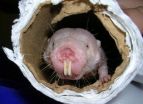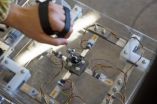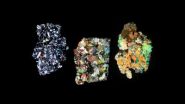(Press-News.org) WORCESTER, Mass. — The movement of genetic materials, such as RNA and ribosomes, from the nucleus to the cytoplasm is a critical component in a cell's ability to make the proteins necessary for essential biological functions. Until now, it was believed the nuclear pore complex was the sole pathway between the cell nucleus and cytoplasm for these materials. New evidence published in Cell by Vivian Budnik, PhD, Melissa J. Moore, PhD, and colleagues at the University of Massachusetts Medical School, reveals a novel budding mechanism, similar to the process used by some viruses, capable of exporting large ribonucleoprotein particles from the nucleus to the cytoplasm.
"The findings in this paper fundamentally change our understanding of mRNA export from the nucleus," said Moore, the Eleanor Eustis Farrington Chair in Cancer Research, Howard Hughes Medical Institute Investigator and professor of biochemistry & molecular pharmacology. "In addition to the canonical pathway of mRNA export going through the nuclear pore complex, we now know that large RNA transport granules can be assembled in the cell nucleus and exported via a budding mechanism previously thought to only be used by the herpes virus."
This study has helped to unravel how RNAs support the development of the post-synaptic apparatus, said Budnik, professor of neurobiology. "It provides new evidence about communication between the nucleus and cytoplasm that have implications for diseases that affect the nuclear envelope such as muscular dystrophies and herpes-type infections such as shingles."
Found along the surface of the nuclear envelope, nuclear pores are small openings that allow certain molecules, such as messenger RNA, transfer RNA and ribosomes, to be transported across this physical barrier that separates a cell's nucleus and DNA from its cytoplasm. Once in the cytoplasm, these genetic materials are the factories and blueprints used by the cell to create proteins. In some cells, these RNAs are bound together in large clusters known as transport granules, which are carried to precise locations within a cell to synthetize specific proteins needed at that site.
"When we look at these transport granules to scale, we see that they're too large to pass through the nuclear pore complex," said Moore. "An open question has been, where are these transport granules first assembled? And if it's in the nucleus, how do they make their way to the cytoplasm?"
Working to understand how synapses develop and communicate with neighboring muscle cells, Budnik discovered a new method whereby these large granules, in the form of ribonucleoprotein (RNP) particles, were transported across the nuclear envelope. Specifically, Budnik and colleagues were investigating how the Wnt/wingless (Wg) protein secreted by the motor neuron initiates a reaction involving the DFrizzled2 (DFz2) receptor on the nearby muscle cell. This interaction between Wg and DFz2 eventually leads a portion of the DFz2 into the muscle cell nucleus where it accumulates around large RNP granules containing messenger RNAs. Once they reach their final destination in the muscle cell cytoplasm, these RNAs are responsible for making the synaptic proteins critical to increasing the size of the junction between motor neuron and muscle cell.
It was while investigating this process that Budnik and colleagues witnessed these large granules exiting the muscle cell's nucleus in an unusual manner. "What was so surprising," said Sean D. Speese, PhD, former postdoctoral fellow in the Budnik lab and currently research assistant professor at Oregon Health and Sciences University, "was that the nuclear DFz2-large-RNPs utilized a novel mechanism for exiting the nucleus, which appeared independent of the nuclear pores and resembled the egress of herpes-type viruses from the nuclear envelope."
During infection, herpes virus particles are assembled in the nucleus. But they are much too large to exit through the nuclear pores. Instead, they bud through the double membranes of the nuclear envelope. To exit the nucleus, the protein shell surrounding the virus disrupts the lamina, a fibrous component located beneath the inner nuclear membrane which, among other properties, anchors the nuclear pore complexes to the nuclear membranes. This allows the virus to bud into the space between the inner and the outer nuclear membrane, becoming enveloped by the inner nuclear membrane. Fusion of this coat with the outer nuclear membrane then allows the virus to be released into the cytoplasm.
"Similarly, we found that DFz2C-RNPs used the same mechanism and viral machinery to reach the cytoplasm," said Speese. Once inside the muscle cell nucleus, the DFz2C RNPs recruit proteins, such as kinase C, to disrupt the lamins, which allows them to bud into the inner nuclear membrane. "In both cases, this process was dependent on an A-type lamina protein, which in humans is associated with a number of muscular dystrophies and early aging syndromes when mutated," said Speese.
Collectively, these discoveries have significant ramifications on our understanding of multiple biological questions including RNA transport, synapse development and the herpes virus, which causes chicken pox and shingles and Epstein–Barr virus, which causes mononucleosis.
###
About the University of Massachusetts Medical School
The University of Massachusetts Medical School, one of the fastest growing academic health centers in the country, has built a reputation as a world-class research institution, consistently producing noteworthy advances in clinical and basic research. The Medical School attracts more than $270 million in research funding annually, 80 percent of which comes from federal funding sources. The mission of the Medical School is to advance the health and well-being of the people of the commonwealth and the world through pioneering education, research, public service and health care delivery with its clinical partner, UMass Memorial Health Care. For more information, visit www.umassmed.edu
Research reveals novel transport mechanism for large ribonucleoproteins
Ribonucleoprotein granules exit the nucleus via a budding mechanism akin to herpes-type viruses
2012-05-11
ELSE PRESS RELEASES FROM THIS DATE:
Long-lived rodents have high levels of brain-protecting factor
2012-05-11
SAN ANTONIO (May 10, 2012) — The typical naked mole rat lives 25 to 30 years, during which it shows little decline in activity, bone health, reproductive capacity and cognitive ability. What is the secret to this East African rodent's long, healthy life?
Scientists from the United States and Israel found a clue. From infancy to old age, naked mole rats are blessed with large amounts of a protein essential for normal brain function.
"Naked mole rats have the highest level of a growth factor called NRG-1 in the cerebellum. Its levels are sustained throughout their life, ...
Helping Hands reaches out to patients with cerebral palsy
2012-05-11
HOUSTON – (May 9, 2012) – With the aid of multiple force sensors and a digital dinosaur, a team of Rice University seniors known as Helping Hands hopes to restore strength and flexibility to the hands and wrists of children with cerebral palsy.
"These kids have a real problem with their hands," said Jenna Desmarais, a senior at Rice majoring in mechanical engineering. "The fingers and wrists are locked into a sort of claw-like position. Even after surgery to correct it, they need physical therapy to get stronger."
The team's rehabilitation device, the Dino-Might, was ...
New twist on ancient math problem could improve medicine, microelectronics
2012-05-11
ANN ARBOR, Mich.—A hidden facet of a math problem that goes back to Sanskrit scrolls has just been exposed by nanotechnology researchers at the University of Michigan and the University of Connecticut.
It turns out we've been missing a version of the famous "packing problem," and its new guise could have implications for cancer treatment, secure wireless networks, microelectronics and demolitions, the researchers say.
Called the "filling problem," it seeks the best way to cover the inside of an object with a particular shape, such as filling a triangle with discs ...
ICU stays for worst asthma drop 74 percent, review finds
2012-05-11
SAN ANTONIO (May 10, 2012) — A review of 30 years of life-threatening asthma cases in a San Antonio intensive care unit found that annual ICU admissions for the condition have dropped 74 percent. The study, by UT Medicine San Antonio physicians who reviewed cases at University Hospital between 1980 and 2010, also showed intubation in the emergency department to help patients breathe did not result in longer hospital stays.
UT Medicine is the clinical practice of the School of Medicine at The University of Texas Health Science Center San Antonio.
Faculty studied inpatient ...
UF study finds logging of tropical forests needn't devastate environment
2012-05-11
GAINESVILLE, Fla. — Harvesting tropical forests for timber may not be the arch-enemy of conservation that it was once assumed to be, according to a new study led by a University of Florida researcher.
Selective logging may be one of the few feasible options left for conserving tropical forests given the huge financial incentives pushing tropical landholders to convert primary forests into cash-generating agricultural plantations.
The report analyzed data from more than 100 studies of tropical forests on three continents that had been harvested for timber. Results ...
CNIO researchers describe a new target for developing anti-angiogenic and anti-tumoral therapies
2012-05-11
Researchers from the Spanish National Cancer Research Centre (CNIO), led by Jorge L. Martínez-Torrecuadrada from the Proteomics Unit, have demonstrated that the antibody-based blocking of ephrinB2, a protein involved in angiogenesis and lymphoangiogenesis, may represent an effective strategy for the development of antiangiogenic and antitumoural therapies.
The results of this study appeared in this month's issue of Blood, the journal of the American Society of Hematology.
CNIO researchers generated highly-specific human antibodies against ephrin-B2 using a phage display ...
Nanotube 'sponge' has potential in oil spill cleanup
2012-05-11
A carbon nanotube sponge that can soak up oil in water with unparalleled efficiency has been developed with help from computational simulations performed at the Department of Energy's (DOE's) Oak Ridge National Laboratory.
Carbon nanotubes, which consist of atom-thick sheets of carbon rolled into cylinders, have captured scientific attention in recent decades because of their high strength, potential high conductivity and light weight. But producing nanotubes in bulk for specialized applications was often limited by difficulties in controlling the growth process as well ...
New report illustrates impact of sequestration to medical research
2012-05-11
The report "Sequestration: Health Research at the Breaking Point," released today by Research!America, demonstrates the damaging consequences of potential automatic spending cuts, or sequestration, to the nation's medical research enterprise and public health, and offers examples on how these cuts would delay scientific discoveries that could lead to new treatments and cures for deadly diseases.
This report provides:
The estimated budget cuts to the National Institutes of Health, the Centers for Disease Control and Prevention, the Agency for Healthcare Research and ...
Dawn reveals complexities of ancient asteroidal world
2012-05-11
TEMPE, Ariz. – New findings from NASA's Dawn spacecraft lay the groundwork for the first geological overview of asteroid (4)Vesta and confirm the existence of not one but two giant impact basins in its southern hemisphere. The findings, published today in a set of Science papers, will help scientists better understand the early solar system and processes that occurred as it formed and evolved.
The Dawn spacecraft, orbiting asteroid Vesta since July 2011, has already acquired several thousand images of the asteroid's surface, revealing a complex landscape. The images ...
Patients see benefits and risks to direct-to-consumer genetics tests
2012-05-11
MAYWOOD, Ill. – Patients see potential benefits from direct-to-consumer genetic testing, but are also concerned about how test results will be used, and generally are unwilling to pay more than $10 or $20 for them, according to focus groups conducted by researchers at Loyola University Chicago Stritch School of Medicine.
Findings by first author Katherine Wasson, PhD, MPH, and colleagues are published in the American Journal of Bioethics Primary Research. Wasson, an assistant professor in Loyola's Neiswanger Institute for Bioethics and Health Policy, is an expert on the ...
LAST 30 PRESS RELEASES:
The Ceramic Society of Japan’s Oxoate Ceramics Research Association launches new international book project
Heart-brain connection: international study reveals the role of the vagus nerve in keeping the heart young
Researchers identify Rb1 as a predictive biomarker for a new therapeutic strategy in some breast cancers
Survey reveals ethical gaps slowing AI adoption in pediatric surgery
Stimulant ADHD medications work differently than thought
AI overestimates how smart people are, according to HSE economists
HSE researchers create genome-wide map of quadruplexes
Scientists boost cell "powerhouses" to burn more calories
Automatic label checking: The missing step in making reliable medical AI
Low daily alcohol intake linked to 50% heightened mouth cancer risk in India
American Meteorological Society announces Rick Spinrad as 2026 President-Elect
Biomass-based carbon capture spotlighted in newly released global climate webinar recording
Illuminating invisible nano pollutants: advanced bioimaging tracks the full journey of emerging nanoscale contaminants in living systems
How does age affect recovery from spinal cord injury?
Novel AI tool offers prognosis for patients with head and neck cancer
Fathers’ microplastic exposure tied to their children’s metabolic problems
Research validates laboratory model for studying high-grade serous ovarian cancer
SIR 2026 delivers transformative breakthroughs in minimally invasive medicine to improve patient care
Stem Cell Reports most downloaded papers of 2025 highlight the breadth and impact of stem cell research
Oxford-led study estimates NHS spends around 3% of its primary and secondary care budget on the health impacts of heat and cold in England
A researcher’s long quest leads to a smart composite breakthrough
Urban wild bees act as “microbial sensors” of city health.
New study finds where you live affects recovery after a hip fracture
Forecasting the impact of fully automated vehicle adoption on US road traffic injuries
Alcohol-related hospitalizations from 2016 to 2022
Semaglutide and hospitalizations in patients with obesity and established cardiovascular disease
Researchers ‘listen in’ to embryo-mother interactions during implantation using a culture system replicating the womb lining
How changing your diet could help save the world
How to make AI truly scalable and reliable for real-time traffic assignment?
Beyond fragmented markets: A new framework for efficient and stable ride-pooling
[Press-News.org] Research reveals novel transport mechanism for large ribonucleoproteinsRibonucleoprotein granules exit the nucleus via a budding mechanism akin to herpes-type viruses


